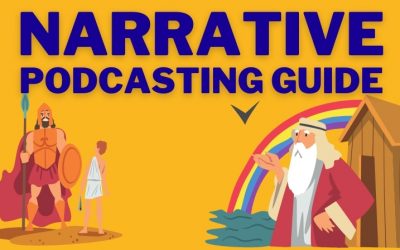There are thousands of podcast shows out there, and that diminishes the odds of you getting discovered by a listener, which is why crafting a compelling podcast description helps you stand out from the competition and attract the attention for your show.
Your goal is to convince your potential audience to choose your show over hundreds of others in a few words kind of like an elevator pitch.
This article will break down the core elements to include in a good description. Additionally, we will expose you to different formats and walk you through a few examples.
What Is a Podcast Description?
Before we go further, I would like to smash up any confusion concerning what a podcast description means.
It is a common mistake to think of a podcast descriptions as show notes. A Podcast description is a brief text that tells people about your podcast, while a show note is a complementary text that describes a single episode.
Now that we have cleared out any confusion, we can get right into the importance of a podcast description.
Why Do You Need a Podcast Description
Researchers have done many surveys on the essential things people look out for, considering a new podcast on the merit of its face value.
Among the other variables presented to the participants (cover art, podcast’s title, frequency of episode releases, the podcast’s rating, and review) podcasts descriptions always came out on top.
This asserts the importance of a well-written podcast description in selling a show to it’s intended audience, as you might already faced the situation where a description either convinced you are scared you away from a show.
How to Compose a Persuading Description

Thinking of a podcast description as the summary on the cover of a book helps to put things in perspective. If you aren’t that interested in books, imagine the text on the back cover of a video game packaging or the summary of a Netflix show.
Check out the descriptions of your favorite podcasts for inspiration will give you an idea on what to include in your own one.
Writing a winning description is not rocket science. Follow the podcast description tips provided in this article and easily compose a text that connects with your potential audience.
Here are the key things to consider while writing a podcast description:
1. Who Is your Podcast For?
The message in your description must speak directly to your target audience.
Knowing the class of people likely to engage with your content gives you insight into composing a description that appeals to their interests.
Gather as much information as you can about your potential listeners such as:
- age and their demographic
- the lingo they use
- their life struggles
- what are they striving for and what are their hopes and desires
- where do they generally hangout
- what’s the best content they like
Knowing so much about them is only going to help you choose the words that will make them want to know more and know that you’re talking specifically to them.
2. What Do You Offer?
Will your show be educational? Are you treating issues in society and suggesting solutions? Do you aim to motivate? Or put a smile on the face and laughter in the heart of your audience?
Obviously, you should know what your podcast is about and whatever the subject, strive to make is the best possible content, on that note I think this article on the 7 pillars of podcast interviews will help you get the most out of a guest appearance on your show.
Make sure to let people know what to expect from your podcast from the start, otherwise they might get confused.
3. What is the structure of your show?
Let your potential listeners know if the content is informal, casual and entertaining, interview-based, a solo show, or involve reviews of some products and services.
If your show is going to be ever changing (flexible) and does not necessarily have an established structure, you should be upfront about it.
4. What Topics Will You Discuss?
Your description should mention the most Important keywords of your niche, citing the subjects, themes, and names the show will revolve around.
It is a bonus to make this part of the podcast description SEO friendly by using tools like “Answerthepublic” to help you find relevant keywords and questions your target audience is asking, use them to optimize your description, and increases the chances of getting discovered on a search engine.
5.What is your podcast release schedule?
Finally, let people know the frequency at which you release episodes for them to expect the release schedule and be there for the drop.
Optionally, you can indicate if your show is a longer format or a short one but it isn’t mandatory as the listener can see how long is an actual episode.
How Long Should a Product Description Last?
Although you have the liberty to express yourself, but it should not be abused as many hosting services cap off the character limit to 600 and some a little bit more, but we recommend sticking to 600 characters as it’s brief and straight to the point.
Worry less about the word count and be more concerned about passing across the message to the reader. Be as precise as possible without leaving out any vital information.
Podcast Description Examples

Example 1:
Let us look at a few podcast descriptions of famous shows that are brief, concise, and engaging.
The example below is the description of the “Louder Than a Riot” podcast. After introducing the podcast host, this description answers the question “What is the structure of your show?”, by educating the reader on the niche the podcast is based on. It goes further to reveal the contents of the show, topics discussed with an interesting use of words, and the manner in which these subjects will be delivered.
“Since its arrival in 2020, Louder Than A Riot’s urgency has grown louder than ever before, with hosts Rodney Carmichael and Sidney Madden delivering some of the most incisive and pertinent investigative journalism in the podcast game. Using the lens of hip-hop to analyze the mass incarceration in America, each episode reflects upon a different hip-hop artist’s story in order to dig deeper into the criminal justice system. The series comes complete with a playlist of the songs used in each episode as a tool for analysis, and features an inside look at the music industry, prison industrial complex, and their intersections in a way that is as thoughtful as it is impactful.’’
Example 2:
The next example description of “The Ezra Klein Show”, and is even briefer than the first. Again, the tone of the show is revealed right after introducing the host. This is followed by a description of the topics discussed and the kind of guests to expect on the show.
“Vox co-founder Ezra Klein’s beloved biweekly podcast has found a new home at the New York Times this year. The series is, as Klein describes, a “conversation show” where Klein sits down with some of the leading experts in the world to pick their brain on the topics that matter most: from climate change to psychedelics and beyond.”
Now that you know the best practices it’s time to craft your winning podcast description
Next: if you haven’t already created a cover art for your show here’s an article to help you understand what you need and start the process: Design a Podcast Cover Art: Guide to make it unique and distinctive






0 Comments